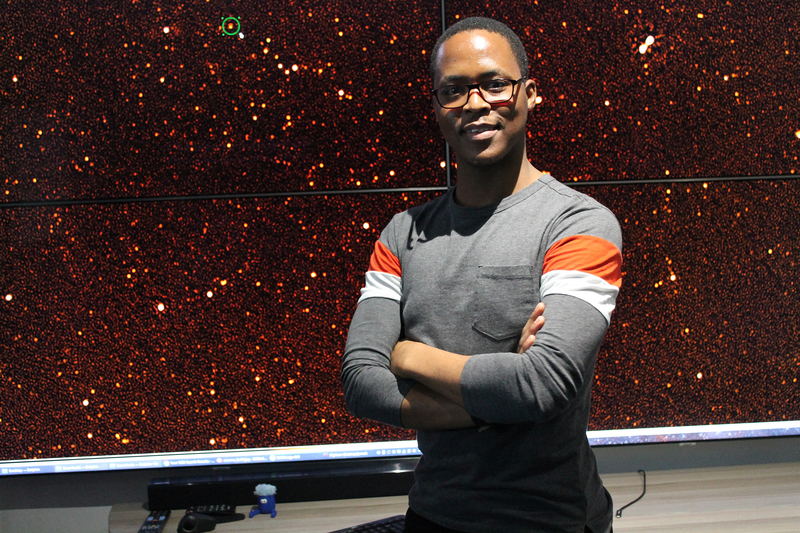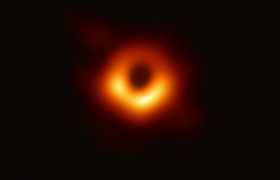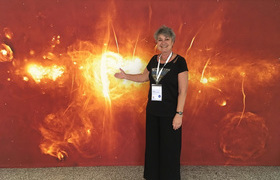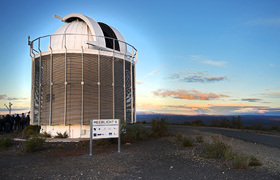The highest energy light from a gamma-ray burst detected
21 November 2019 | Story Supplied. Photo Siphelo Funani. Read time 5 min.
While it has been decades since the discovery of the first gamma-ray bursts (GRB), some of their fundamental traits remain a puzzle. Astronomers from the University of Cape Town (UCT), including Professor Patrick Woudt and MSc student Reikantseone Diretse, are part of an international team of more than 300 researchers that has gained further insight into the physical processes at work during these events.
The team accomplished this through the observation of a GRB with an afterglow featuring the highest energy photons ever detected in these events: photons a trillion times more energetic than visible light.
GRBs are the most luminous explosions in the cosmos. These explosive events last several seconds and during that time they emit the same amount of gamma-rays as all the stars in the universe combined. Such extreme amounts of energy can only be released during catastrophic events like the death of a massive star, or the merging of two compact stars, and are accompanied by an afterglow of light over a broad range of wavelengths (or equivalently energies), that fades with time.
On 14 January 2019 researchers detected GRB 190114C. It is unique in that researchers were able to observe for the first time in its afterglow emission photons with teraelectronvolt (TeV) energies, using the Major Atmospheric Gamma Imaging Cherenkov (MAGIC) telescope in the Canary Islands.
According to Professor Chryssa Kouveliotou of George Washington University in the United States, a collaborator on the MeerKAT team, “MAGIC (the TeV photon detector) opened up a new window on GRB research, and we are looking forward to understanding their physics and true energy release with more detections in the future.”
This emission of TeV photons was 100 times more intense than the brightest known steady source at TeV energies, the Crab Nebula. As expected, the very high energy emission faded quickly – in about half an hour after the event onset – while the afterglow emission in other parts of the spectrum persisted for much longer.
“Researchers were able to observe for the first time in its afterglow emission photons with teraelectronvolt (TeV) energies.”
The discovery triggered an extensive campaign of observations across the electromagnetic spectrum, mobilising more than 20 observatories and instruments around the world. This collaborative effort allowed researchers to gather the most information ever collected about a GRB, capturing the evolution of the GRB afterglow emission across 17 orders of magnitude in energy.
Monitoring radio waves
Woudt and Diretse were part of a team responsible for tracking the emission of radio waves in the afterglow of GRB 190114C. The team used the new MeerKAT radio telescope in South Africa to record the emission. While gamma rays are very high energy photons, radio waves are found at the other energy end of the electromagnetic spectrum.
“The rapid response of the MeerKAT telescope to observe this extreme stellar explosion, combined with its excellent sensitivity, has allowed us to detect the radio afterglow within 24 hours of the explosion,” Woudt explained.
Diretse continues to monitor the radio afterglow of this event using MeerKAT.
“The recording of TeV energies for GRB190114C and its continued monitoring with radio telescopes such as MeerKAT helps us to untangle the high energy astrophysics of these exciting transient events. Being part of such a discovery was ecstatic and highly motivating,” he said.
His study is supported by a postgraduate scholarship from the Inter-University Institute for Data Intensive Astronomy (IDIA), a partnership between UCT, the University of the Western Cape and the University of Pretoria. The research cloud computing infrastructure of IDIA has contributed towards the fast analysis of the MeerKAT observations of GRB190114C.
“This amazing scientific achievement underscores the importance of the ability of South African researchers to rapidly analyse large MeerKAT data sets with the data-intensive research cloud developed at IDIA,” said Professor Russ Taylor, director of IDIA.
Rob Adam, managing director of the South African Radio Astronomy Observatory (SARAO) concurred: “Once again we see the potential of the MeerKAT telescope in finding interesting and possibly new astrophysical phenomena, as well as the power of the multi-wavelength approach to the analysis of observations.”
The findings of the research were announced in the study, “Inverse Compton emission revealed by multi-wavelength observations of a gamma-ray burst”, published on 21 November in Nature.
Read the full study in Nature.
 This work is licensed under a Creative Commons Attribution-NoDerivatives 4.0 International License.
This work is licensed under a Creative Commons Attribution-NoDerivatives 4.0 International License.
Please view the republishing articles page for more information.










